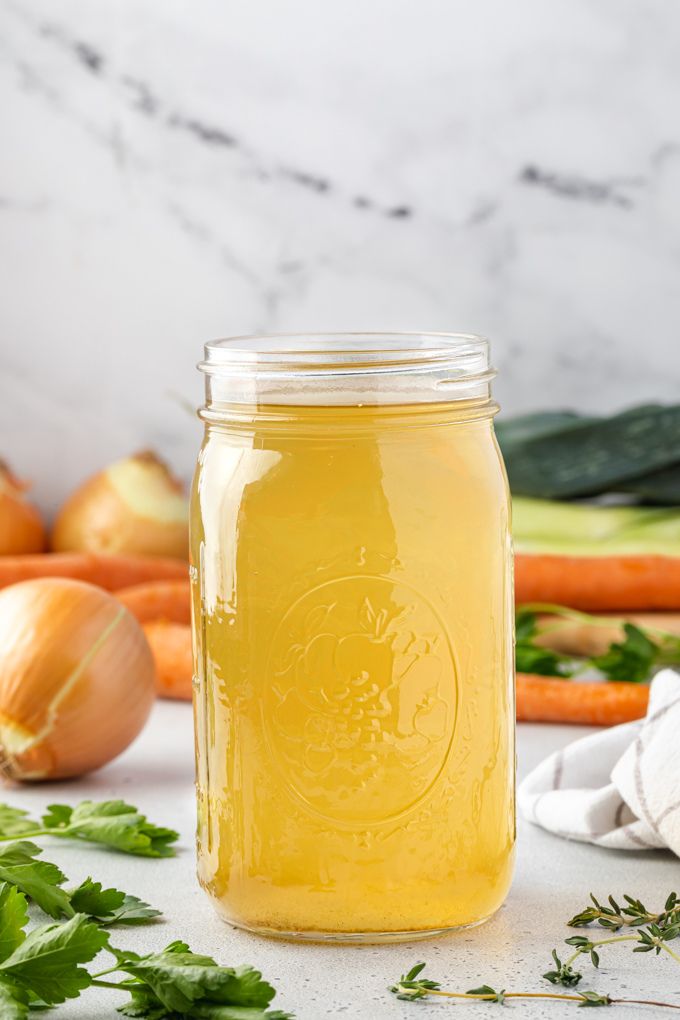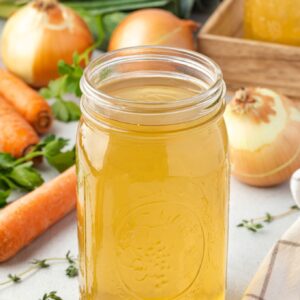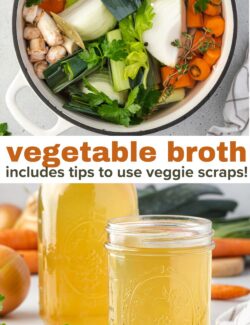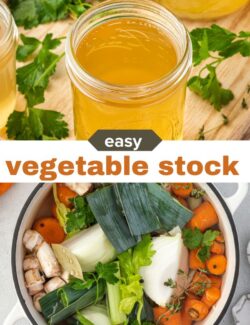Homemade Vegetable Stock
This Homemade Vegetable Stock is so fresh tasting and easy to make that you’ll never buy it again! You control the flavor and sodium, and it’s a great way to utilize those veggie scraps. It’s freezer friendly and the recipe includes cooking methods for the stove top, slow cooker and Instant Pot!

I experienced some of the best food of my life in cooking school, and quickly learned that homemade stock was one of the best ways to elevate a dish.
I love having a big stash of chicken stock, turkey stock and this Homemade Vegetable Stock on hand because they add so much amazing flavor to my recipes.
Why make homemade veggie stock? If you use it often, you know that store bought brands are not created equally.
Some brands have a strong flavor and even a deep color that changes the entire flavor and color of the dish I’m trying to prepare.
They can also be very high in sodium, so it’s nice to be able to control what goes into it and reduce veggie waste.
You’ll be amazed how easy it is and what a difference it makes in your dishes!
Table of contents

Why you’ll love this recipe
- Making your own vegetable stock at home is a great way to save money, reduce food waste, and bring your cooking to a whole new level of deliciousness.
- Not only is it healthier than store-bought stock, but it’s easier than you think.
- You’ll learn how to make your own vegetable stock from scratch using one of three cooking methods, and which vegetables you should select.
- You’ll also learn how to store and freeze your stock for later use and get ideas about how to use the finished product in your favorite meals.
Recipe ingredients

- Vegetables. Consider vegetable stock a blank canvas to be used in a variety of dishes. The best vegetables to use are onions, leeks, carrots, celery and mushroom tops as they add a nice, clean flavor. Other varieties and veggie scraps may be used as well…see the FAQs section for more information.
- Herbs. Bay leaf and sprigs of fresh thyme and parsley are essential for a flavorful stock.
- Peppercorns. The peppercorns add great flavor and should not be omitted. Salt is not added as the stock is used as an ingredient in recipes.
- Other options. See the FAQs section below regarding vegetables and veggie scraps to add, and which varieties should be avoided.
How to make vegetable broth
Homemade vegetable broth couldn’t be easier to prepare, and you’ll be amazed how much more flavorful it is than store bought.
The instructions below cover how to make it on the stove top. See the recipe card notes for instructions on making vegetable broth in the slow cooker and Instant Pot.
Pro tip: Vegetable scraps are great for stock! Save the ends from carrots, celery, leek tops, mushroom stems, onions and store in an airtight container in the fridge until you’re ready to make your stock or freeze for later use.
See the recipe card below for full instructions.

- Wash the vegetables thoroughly and cut them on a cutting board.
- Place the vegetables, herbs, bay leaf and peppercorns in a large Dutch oven or pot and add the water.
- Bring to a boil over high heat, then reduce the heat and simmer for about one hour.
- Strain the broth over a large bowl.
- Allow the veggie stock to come to room temperature.
- Portion into jars or containers and store in the refrigerator or freezer.

Recipe FAQs
The terms vegetable stock and broth are often used interchangeably, but there is a difference between the two.
Vegetable stock is an ingredient that is a foundation of many recipes, so it’s prepared with clean flavors and is unseasoned. It is typically made with onion, carrots, celery, bay leaf, parsley, thyme and peppercorns, and simply enhances the dishes that it’s added to.
Vegetable broth, on the other hand, is meant to be enjoyed as-is, so it’s seasoned and can be flavored with a variety of vegetables for added flavor.
The best vegetables to use for veggie stock are onions, carrots and celery. These are included in the classic French mirepoix, and add a nice clean flavor to the stock.
Mushrooms and leeks are also great additions as they don’t overpower the flavor the stock.
There are several other veggies that are great for stock as well, including parsnips, fennel and garlic, but they will change the flavor of the stock. Experiment by adding some of your favorite veggies!
Avoid adding cruciferous veggies like broccoli, cauliflower and brussels sprouts, as well as rutabagas, turnips, cabbage and artichokes, as they will add a bitter flavor to your stock.
You can easily make a delicious homemade veggie stock with vegetable scraps, so be sure and save them!
Do not use veggie scraps from cruciferous veggies, kale or arugula as they will add a bitter flavor to the stock.
Store a large Stasher or zip top bag in the refrigerator or freezer and add veggie scraps like onion peels, carrot peels, mushroom stems, leek tops, celery leaves and bottoms.
When the bag is full, place the scraps in a pot along with parsley, thyme, a bay leaf and 6 peppercorns and fill with enough water to cover by 1″, then simmer for one hour.
It will keep in the refrigerator for up to one week, or store in the freezer for 3-6 months.
I love using Souper Cubes to store the stock in 1 cup and 2 cup portion sizes.

Recipe notes
- Pro tip: Vegetable scraps are great for stock! Save the ends from carrots, celery, leek tops, mushroom stems, onions and store in an airtight container in the fridge until you’re ready to make your stock or freeze for later use.
- This recipe is a rule of thumb. You can change the quantities of the vegetables depending on what you have. Feel free to experiment with other vegetables as outlined in the FAQs section above.
- Avoid using vegetables with strong flavor such as cabbage, brussels sprouts, broccoli, cauliflower, turnips or rutabagas as they will add a bitter flavor.
- I don’t add salt to my veggie stock as I like to wait until I add it to my dishes.

Ways to use veggie stock:
- Use it as the liquid to cook polenta and rice pilaf for added flavor.
- Use it as a flavorful base for soups such as minestrone soup with spinach and carrot ginger soup.
- It adds tons of flavor to dishes such as mushroom risotto and Mexican quinoa.
- It’s a great way to make pasta primavera and Thai pasta next level!
Did you try this recipe? If so, be sure to leave a review below and tag me @flavorthemoments on Facebook and Instagram

Homemade Vegetable Stock
Ingredients
- 1 yellow onion quartered
- 2 leek tops sub with another onion or (2) fennel tops
- 2 stalks celery cut into large chunks (include leafy tops if you have them)
- 2 large carrots cut into large chunks
- 1 cup mushroom stems optional
- 1 bay leaf
- 2 large sprigs flat leaf parsley
- 2 large sprigs thyme
- 6 peppercorns
- 8 cups water or up to 10 cups
Instructions
- Place all ingredients in a large soup pot and bring to a boil over high heat. Once boiling, reduce the heat to low and simmer for one hour.1 yellow onion, 2 leek tops, 2 stalks celery, 2 large carrots, 1 cup mushroom stems, 1 bay leaf, 2 large sprigs flat leaf parsley, 2 large sprigs thyme, 6 peppercorns, 8 cups water
- Set a strainer over a large bowl and line with cheesecloth if necessary. Pour the stock into the strainer and discard the solids.
- Cool completely then store the stock in an airtight container in the the fridge for up to 1 week or freeze for up to 6 months.
Notes
- Pro tip: Vegetable scraps are great for stock! Save the ends from carrots, celery, leek tops, mushroom stems, onions and store in an airtight container in the fridge until you’re ready to make your stock or freeze for later use.
- This recipe is a rule of thumb. You can change the quantities of the vegetables depending on what you have. Feel free to experiment with other vegetables as outlined in the FAQs section above.
- Avoid using vegetables with strong flavor such as cabbage, brussels sprouts, broccoli, cauliflower, turnips or rutabagas as they will add a bitter flavor.
- Instant Pot Vegetable Stock: Place all ingredients in the Instant Pot and lock the lid in place. Select the Pressure Cook button and set it to High pressure for 15 minutes. Allow the Instant Pot to naturally release pressure, then unlock and remove the lid.
- Slow Cooker Vegetable Stock: Place all ingredients in the slow cooker. Cover and cook on low for 6-8 hours or high for about 3-4 hours.
Nutrition
Nutrition is estimated using a food database and is only intended to be used as a guideline for informational purposes.
**This recipe was originally published in January 2018. The photos have been updated to include step by step photos and the text has been modified to include more recipe information and better readability.






21 Comments on “Homemade Vegetable Stock”
I will definitely make the vegetable stock recipe. I would appreciate providing a list of other vegetables that will not overpower vegetable stock. Thank you for your stock recipe.
There is already a list of which vegetables to avoid. Hope you enjoy the stock!
This looks and sounds so good that you make me want to make it right now! You mentioned to include celery leaves with the celery stalks. Something I like to do with the celery leaves is to dry the leaves in the oven and store them for flavoring when I don’t have celery on hand. I love the gentle salty flavor of fresh celery.
That’s a handy tip Sandra — I’ll have to remember that!
I often use a vegetable stock but I’ve never thought that I can prepare it at home, Marcie! Thanks a lot for the easy and detailed recipe!
You’re so welcome Agness! 🙂
They are the best — thank you Puja!
This stock looks seriously SO amazing, Marcie! I watched one of my vegetarian classmates make veggie stock in culinary school once and sadly never got around to doing it myself! DEFINITELY giving this one a try asap!
Thank you Sarah! It’s SO easy to make this so I have zero excuses not to! 🙂
I go through so much stock – I love making my own! I usually wait until I have turkey bones saved up but I’m loving that I can use vegetables in this way!!
Thanks Katherine! I use so much veggie stock these days so it’s worth making my own!
I seriously need to start making my own stock again. I make soup for lunch on a regular basis so I might as well have homemade stock on hand! Thanks for the inspiration! 🙂
It definitely takes time to make your own stock but it’s so worth it! Thanks Christina!
I definitely need to try making veggie stock in my Instant Pot! Such a great idea to include options for Instant Pot, stove top and slow cooker. And I love that you’re going back to older posts to add the Instant Pot options!
The Instant Pot is my favorite thing ever right now…I wish I’d have gotten it sooner!
I love that you made this in the instant pot, Marcie! I’ve been playing around with mine, but have yet to make soup or stock in it. I love how easy this is and also how much flavor it has! Sound like the perfect base for just about anything!
Thanks so much Gayle! The Instant Pot is amazing and I wish I had bought one sooner!
Nothing beats homemade stock, but I love that you’ve quickened the process by using the instant pot!! This is brilliant, Marcie!! I’m looking forward to seeing more IP and one pot meals from you, and I know they will be delicious!! Cheers!!
The Instant Pot has change my life and I can’t believe I resisted it for so long! Thanks Cheyanne! 🙂
I always mean to make my own veggie stock … and then I just never get around to it. haha Womp womp. I really need to give this a go!
I just started storing odds and ends of scrap veggies in my fridge to remind myself and if it doesn’t work out I sock them in the freezer for later! I hope you’re able to try it some time!